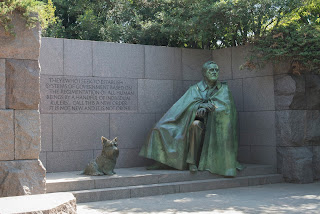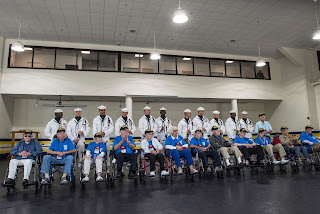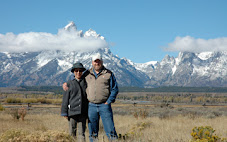Our flight leader is Candice Pierucci, who together with her husband of four months, Andy, put together a very impressive experience for the veterans and their guardians. Each flight is a little different, and I think we benefit a lot from the experience UT Honor Flight has gained over the past couple of years. We visit sites and experience things that are a first for the Honor Flights.
Mel was drafted into the Navy right out of high school at
age 18. He completed a compressed, three-week boot camp in San Diego and spent
a month in gunnery school. He was assigned to the troop ship Puebla as a gunner
manning a three-inch, antiaircraft gun mounted on the bow of the ship. His ship
was a captured German luxury liner that still had shuffleboards on the decks, it used the swimming pool as a cargo hold. The Puebla picked up Army troops in San
Francisco and New Guinea and disembarked them in the Philippines and elsewhere.
On Mel’s second trip to the Philippines aboard the Puebla, the ship, which was
equipped with a hospital, picked up a large number (maybe a couple thousand) of liberated U.S. prisoners
of war who had suffered through the Bataan Death March. On his third trip from
the Philippines to San Francisco, the ship stopped at the island of Palau, and
it was while it was there that the war ended to flares, fireworks and cheers.
Mel was then put in charge of a battery of 20mm antiaircraft
guns on the newly built aircraft carrier Palau at Bremerton, Washington, and
participated in a month-long shakedown cruise. The ship was to become the
flagship of the U.S. Atlantic Fleet and sailed through the Panama Canal to
Boston, where Mel met his future bride, Sarah Hart. He was honorably discharged
at Norfolk, Virginia.
The Utah Honor Flight starts on the morning of Thursday, September 17, at 7 a.m. in the Senate room of the Utah State Capitol.
We have a light breakfast.
A Revolutionary War-era Honor Guard flag ceremony.
And a Utah National Guard brass band.
The Utah Highway Patrol and a few members from the Patriot Guard motorcycle club escort our two buses to the SLC Airport.
One of the most impressive experiences of the trip is the many people waiting for flights in the airport standing to clap, shake hands, and shed some tears as they thank the veterans passing by in single file.
And of course, when you're in a large group like this you get used to waiting to board planes or buses throughout the trip. All in all, the Utah Honor Flight staff has this whole trip very well organized, and we move as efficiently as is possible with a crowd of a hundred people. (We don't actually have a hundred in the SLC Airport. There are about 48 veterans, each with a guardian, and the UT Honor Flight volunteers. We meet up with another 25 or so veterans and their guardians from Washington County in DC. They fly out of Las Vegas.
Dad waiting in the airport with the National Guard in the background. They drive the buses and escort us through the airport.
On our Southwest flight to Baltimore Airport (BWI).
On the plane is "mail call," when the veterans receive a packet of letters from family at home. Dad receives a lot.
KSL documents much of the trip. In addition to the video, there is also a KSL radio reporter documenting the trip. A reporter from Saint George also videotapes interviews.
The BWI Fire Department shoots water canons to welcome the veterans.
At BWI we do a little more waiting and bathroom breaking.
Then we board a bus for the Westin Dulles. I know, we fly into one airport and then take a bus to a hotel at a different airport. Flying into Dulles is expensive. (I need to go there in November, and flying to Dulles would be $750. I chose to fly into BWI for just over $300 and will rent a car to drive to DC.)
The Westin welcomes the vets with a cookie and letter in the room.
Dinner on Thursday night is chicken pot pie with a nice flakey crust on top.
We share a table with a vet who was officially in the Korean War, but he actually served on a plane in the Berlin Air Drop. His job was to level the coal the plane hauled into Berlin so the plane would fly balanced. He later became a civilian airplane mechanic at Hill Air Force Base and never saw Korea.
Westin breakfast on Friday morning. Big breakfast for a full day.
The hotel also has a welcome for the vets in the lobby.
Marc Giauqu (Juke) from KSL radio accompanies the group throughout the trip. He posts reports and streams to social media.
On the bus. Off the bus. Many times. Each time is the same routine: Guardians disembark first, unfold a wheelchair (called chariot, manual personnel carrier, mobile device--anything but "wheelchair").
The first stop is the WWII Memorial at the Pacific entrance. The Atlantic entrance is on the opposite side. The park employee is in period uniform. He even ordered his brand-new boots from a company that makes replicas for movies, and they're authentic down to the model number stamped in the insole.
Waiting at the WWII Memorial for the ceremony.
The ceremony includes a "thank you" speech and singing the "Star Spangled Banner."
The guy with the brown jacket on the right side of this photo is always cold. He wears gloves, a jacket and a cap with his Honor Flight hat on top of that in the 85-degree weather. On the bus the nurse gives him a blanket that he asks me to pull up over his shoulder. Funny guy with a very deep voice. He is 93 years old and competed in Iron Man competitions into his 80s. He is also training now for a 10K race.
Orrin Hatch (Utah senior senator) and Rob Bishop (Utah representative) shake hands and speak with the veterans. As the senior member of the majority party (Republicans) in the senate, Hatch is senate pro tempore and fourth in line for the U.S. presidency if something should happen to the president, vice president and speaker of the house. Thus he gets Secret Service protection.
Hatch meets and greets veterans.
Each state has a tower with two bronze wreaths at the WWII Memorial.
Each of 4,048 gold stars represents 100 men and women who died fighting in World War II.
Dad served in the Southwest Pacific.
The Washington Monument and Reflection Pool.
The Gettysburg Address is carved into the stone at the Lincoln Memorial. After the WWII Memorial ceremony we have a couple hours free to wander the National Mall to visit here and the Vietnam and Korean War Memorials.
Two great men.
The Lincoln Memorial is, of course, a must-see for tourists.
I think the Korean War Memorial is the most moving memorial. Stainless steel statues of soldiers trudging through the Korean landscape are reflected in this polished black granite wall that is etched with real photos of people in the war.
The Korean War soldiers represent many ethnicities. It's very realistic.
Lunch near the Korean War Memorial is turkey, ham or beef Arby's sandwiches, potatoes chips, fruit cocktail and a cookie. So is lunch each day and dinner on the plane home.
Those buses again.
Next we visit the Franklin Delano Roosevelt memorial. This is an interesting wandering path of rock walls etched with FDR sayings.
This is FDR with his dog.
Sitting next to a tidal basin off the Potomac with the Thomas Jefferson Memorial in the background.
The Martin Luther King Memorial is also on the tidal basin.
Martin Luther King, Jr.
The Washington Monument reflected off the tidal basin.
A new Women's Memorial is at the edge of Arlington National Cemetery. Three WWII women veterans are on our flight, and they are each honored with their photo and biography loaded to the database that will feed monitors in the memorial for future visitors.
Our last stop on Friday is the Tomb of the Unknown Soldiers at Arlington National Cemetery to watch The Changing of the Guard.
The soldiers who apply for and are accepted as guards here commit to a four-year duty. They must be between 5'10" and 6'2" and have a waist not larger than 30 inches. They spend five hours each day preparing their uniform, which is free of all lint. They also commit to avoid alcohol and refrain from swearing for the rest of their lives.
The soldier drags his shoes when veterans are present.
The audience must remain absolutely silent and standing throughout the Changing of the Guard ceremony.
Thousands of headstones.
In the evening we return to the Westin for dinner and a ceremony honoring the veterans.
Meatloaf.
Candice in period dress sings "Danny Boy."
Mike Turner, the chairman of the Utah Honor Flight, thanks the veterans.
Lt. Jeff (I need to find his full name) of the National Guard addresses the veterans in a speech that is just the fifth length (short). He tells of his father, who was a helicopter pilot in Vietnam (that's his helmet). His dad didn't share war stories, because they were "classified." When Jeff attained a rank with sufficient security clearance, he asked his dad to tell him of his experiences, but his dad didn't want to. His dad died about a year later of cancer. Jeff encourages the vets to share their stories, good and bad, with their children, grandchildren and great-grandchildren.
At the end of WWII, Congress approved a Victory Medal for every soldier, but it never appropriated nearly enough money to actually create and distribute more than 800,000 medals for the 16 million who served. So the Utah Honor Flight had a man who owns a foundry in Spanish Fork to forge these identical medals, and they are attached to ribbon from 1945.
Dad visiting with Representative Lee Perry.
The three Utah House representatives who accompanied the vets on this Honor Flight are, left to right: Lee Perry, Brad Dee, and Steve Handy, with Mike Turner on the right end.
On the bus Saturday morning.
Our first stop is the Marine Memorial, otherwise known as Raising the Flag on Iwo Jima. This scene, which was captured on film by Joe Rosenthal of the Associated Press, was actually the second flag raised on Iwo Jima. The first flag was raised by a group of Marines who fought their way to the top of Mt Suribachi, but the flag was small, and the commander sent another group to raise a larger flag that could be seen from anywhere on the small island.
The battle with the Japanese continued for several days after this raising. In that battle three of the six Marines who raised this flag were killed. One later died of a heart attack at age 54. One died of alcoholism and exposure. And one died of a heart attack at age 70.
The Air Force Memorial doesn't fit in a photograph without a fisheye lens, which I don't have with me. Three stainless steel towers represent the "missing man" formation of three jets soaring and separating.
From the Air Force Memorial you can see the Pentagon in the foreground and the Washington Monument in the background.
We have two more very impressive events for the day. The first is a stop at the Joint Anacostia-Bolling military base to see the Navy Drill Team perform.
These young men must practice on the drill team for a year before they're allowed to perform in public. They practice 12 hours per day five or six days a week.
They are very impressive.
Posing with the Navy veterans on the Honor Flight. Most of the soldiers on this flight are Navy veterans. Also represented are the Air Force, Marines, Army and Coast Guard.
Our last stop is Fort McHenry, which England bombarded from ships in 1814 in preparation to invade Baltimore after they'd burned the White House during the War of 1812. I love this place, and we've been here several times, but today's experience will be different and a highlight.
The veterans unfurl a replica of the 30-foot by 42-foot flag that flew over the fort when Francis Scott Key wrote the words to the Star Spangled Banner on a British ship that was bombarding the fort throughout the night. He was on the ship as a lawyer negotiating the freedom of an American man the British were holding. They wouldn't let Key off the ship because they were planning to attack that night.
The Park Ranger relates how Key wrote the Start Spangled Banner not so much with poetic words but with a straightforward description of what he witnessed. For example, the stars on this particular flag are angled to they point to the right on one row and to the left on the next row. This is called "spangling" and applies only to this particular U.S. flag.
As Key and citizens in Baltimore watched the battle throughout the night, they knew by the bombs bursting in air that the British had not yet captured the fort, because had they captured the fort, the shelling would have stopped. At dawn's early light, Key strained to see through the smoke whether they flag was still flying. At 9 a.m., as with every day at this time, and as the smoke cleared, the soldiers in the fort took down the smaller flag that flew at night (and was tattered from the firefight), fired a canon and raised this giant flag. The British had given up. The soldiers then heard the roar of 50,000 residents of Baltimore cheering from their rooftops.
The pilot of our Southwest flight back to SLC.
Once in Salt Lake, the vets shake hands with about 30 members of the motorcycle Patriot Guards lining the walkway, each holding a large U.S. flag on a pole. And we head back to the State Capitol with a Highway Patrol car with lights on and the Patriot Guards escorting us for a welcome by family and friends.
A lot of people pack the rotunda.
The veterans sit across the front.
Candice and Andy Pierucci express their gratitude to the veterans.
Dad's welcoming party.











































































